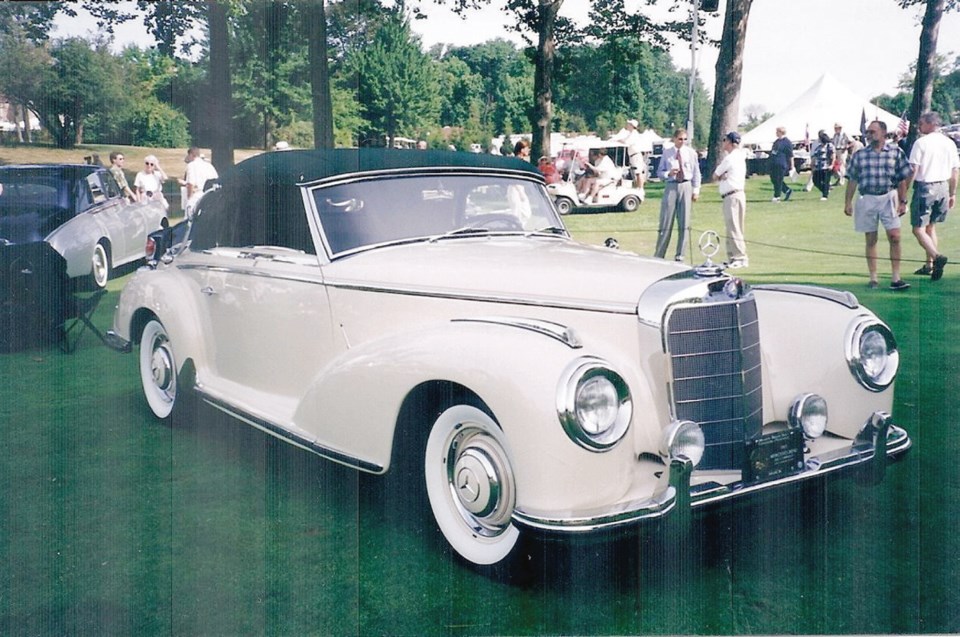By the end of the Second World War, the automobile plants of Germany’s Daimler-Benz (now Daimler AG) were so badly bomb-damaged that the board of directors despairingly concluded that the company had “ceased to exist.”
But despite this pessimism, desperate workers began returning to the factories near Stuttgart and removing rubble and restoring machinery. The plant started by repairing American trucks and was soon reconditioning pre-war Mercedes-Benz 170V models.
In 1946, D-B was given permission by the Allies to resume building new pre-war-designed four-cylinder 170Vs and 170Ds (diesel) cars. By the end of 1947, almost 1,000 had been produced, some configured as light trucks to fill an acute hauling shortage.
Work was also underway on developing new models, which appeared as the 1951 Mercedes-Benz 220 2.2-litre and 300 3.0-litre sedans, both with six cylinders. The 220 was a mid-market car while the larger, more substantial 300 immediately established itself in the top class of European luxury cars. Introduced at the Frankfurt Auto Show in April 1951, it was the biggest, fastest German car built. It became such a favourite of German chancellor Konrad Adenaur, it was dubbed the “Adenauerwagen.”
While the 300 was large by European standards, its 4,877-millimetre length and 3,048-mm wheelbase were modest compared with American cars. The 1951 Cadillac 61, Cadillac’s smallest model, was 5,385 mm long with a 3,099-mm wheelbase. The 300 was about the size of a Chevrolet.
Some of the 300’s technical features were more advanced than American cars. It had four-wheel independent, swing-axle coil spring suspension and an auxiliary, electrically operated torsion-bar system that kept the car level under all load conditions.
The 300’s 3.0-litre inline six-cylinder, seven-bearing engine with a chain-driven, single overhead camshaft and twin carburetors developed 115 horsepower, considerably less that the 160 of Cadillac’s 5.4-litre overhead-valve V-8, although its specific output of 38.3 horsepower per litre was higher than Cadillac’s 29.6. Power was sent to the rear wheels through a four-speed, all-synchromesh, column-shifted manual transmission.
With only115 horsepower to move 1,792 kilograms, the 300’s performance was modest. Road & Track recorded zero to 100 km/h in 16.1 seconds and top speed of 159 km/h. Rival Jaguar’s Mark VII sedan with a twin-overhead-cam 3.4-litre, 160-horsepower six, and weighing the same as the 300, accelerated to 100 in 12.6 seconds and reached 167 km/h. And at just over $4,000, the Jaguar was almost $3,000 cheaper.
While D-B had the 300 sedan under development, it was also designing a sportier, more glamorous version, the 300S. Introduced at the Paris auto show in October 1951, six months after the 300, it came as a coupe or convertible and its front seat accommodated two and occasionally three passengers. There was also a small emergency rear seat.
The 300S was 356 mm shorter than the 300, had a shorter 2,911-mm wheelbase for crisper handling, and weighed about 204 kg less. The 300S engine was upgraded with three carburetors, higher compression and other modifications, bringing horsepower to 150. This raised top speed to 177 km/h and reduced zero-to-100 time to under 15 seconds.
The 300S’s interior was truly sumptuous with leather seats, cut-pile wool carpets trimmed with leather and rosewood or burled walnut trim. Fitted leather luggage was also available and the body was beautifully finished in lacquer laboriously sanded and polished by hand.
The 300S received mechanical upgrades along the way. In 1954, the brakes were improved with finned aluminum drums and vacuum assist. For 1955, it received fuel injection, raising horsepower to 150 and top speed to 185 km/h. Zero to 100 km/h dropped to 13 seconds. Also introduced were dry-sump lubrication and D-B’s clever low-pivot swing axle rear suspension that required only one universal joint rather than two.
The 300S was a superb carriage for touring in the grand manner. At over $12,000, it was also the most expensive car sold in North America. Over its seven-year run from 1952 to ’58, only 760 were built, compared with more than 11,000 300 sedans. This gave it an exclusivity that set its owner apart as someone of wealth and taste. Owners were such celebrities as actors Clark Gable and Gary Cooper and crooner Bing Crosby.
Although overshadowed by the arrival of the magnificent 1954 Mercedes-Benz 300SL gullwing coupe, the 300S was a true gentleman of distinction that retained its luxurious place in the Mercedes lineup until 1958.
